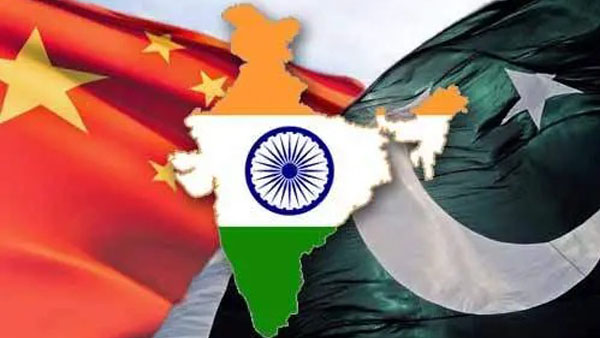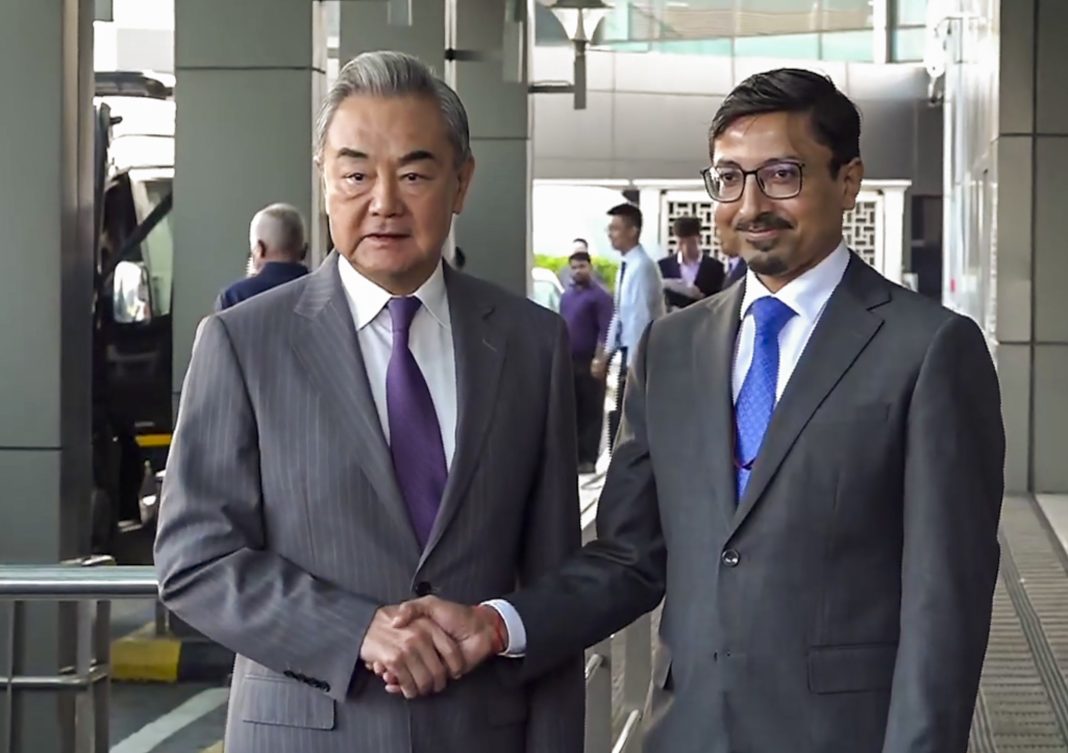By Dipak Kurmi
The re-entry of Chinese Foreign Minister Wang Yi into New Delhi’s corridors of diplomacy, after an absence of more than three years, comes at a moment of layered strategic calculations and unresolved historical grievances. His visit, framed in the capacity of Special Representative on boundary talks, mirrors the December 2024 visit of India’s National Security Adviser Ajit Doval to Beijing. It symbolizes a thaw in engagement but falls far short of offering a return to the elusive “normalisation” in relations that Prime Minister Narendra Modi has publicly tied to the restoration of peace and stability along the Line of Actual Control (LAC). Since the violent clashes of 2020 in Galwan Valley, which claimed lives on both sides, trust has thinned, and every handshake is shadowed by the memory of those rocks and ridgelines.
China’s insistence on shifting ground realities at the LAC has made India wary of what “normal” truly means. Delhi has frequently reminded Beijing that relations cannot revert to the pre-2020 status quo without disengagement and restoration of unhindered Indian access to patrol points that were systematically blocked. The irony is stark: this fragile outreach between two of Asia’s giants is not born of hard-won compromise, but of tactical necessity, and in many ways, it appears to benefit Beijing more than New Delhi. Instead of basking in geopolitical advantage, India has found itself boxed into a deadlock—an uninhabitable no-good, no-go zone in the strategic imagination of South Asia.
A major reason for this awkward positioning lies in India’s simultaneous entanglement with Pakistan. The very word “Pakistan” in India’s strategic vocabulary has ceased to represent just a nation-state; it has become shorthand for disruption, distraction, and the diversion of national bandwidth. This oversized psychological and political space that Pakistan occupies has been one of New Delhi’s chronic vulnerabilities, one that Beijing has long learned to exploit. The collapse of Pakistan’s governance structures, the persistent use of terror proxies, and the failure of Islamabad to create any credible economic or political model have left China with a pliable partner at India’s western flank. From the Belt and Road Initiative through the China-Pakistan Economic Corridor to overt military assistance, Beijing has stitched together a long-term insurance policy against India’s rise, leveraging Pakistan as a perennial thorn.
India’s predicament is worsened by its Pavlovian reflex to Pakistani provocations. Every skirmish across the Line of Control, every terrorist infiltration, and every rhetorical outburst from Islamabad drags New Delhi into a cycle of offense and counter-offense. Rational strategic logic gives way to sentiment-driven responses, often demanded by the emotional hackles of an Indian public conditioned over decades to equate toughness with immediacy. Thus, while Chinese manoeuvres at the LAC unfold with the subtlety of chess, Pakistan’s jabs resemble the bluntness of street brawls. Yet, in both cases, India finds itself reaching, reacting, and repositioning without the breathing space to set its own agenda.
This dual-front dilemma exposes the inadequacy not merely of India’s military resources but also of its political imagination. The persistence of Pakistan in the national psyche ensures that debates on security rarely transcend the visceral. As a result, India’s China policy is often burdened with emotional excess, even though Beijing neither excites nor provokes the Indian public with the same intensity. This mismatch produces a paradox: while China is the more formidable long-term challenge, it often remains underexamined in public discourse compared to the fury directed at Pakistan.
The return of Wang Yi to New Delhi does not alter these fundamentals. Beijing has shown no inclination to relax its hold over disputed sectors or roll back the forward deployments that began in 2020. Indian patrol access remains restricted, while Chinese military positions on the high ridges suggest entrenchment rather than disengagement. Eastern Ladakh has slipped from the daily headlines, but the absence of visibility does not equal the absence of danger. India cannot ascertain whether the disengagement is partial or cosmetic, or whether Chinese troops have simply pulled back to fortified positions beyond immediate observation.
Complicating matters further is China’s growing involvement in South Asia’s triangular geopolitics. In recent years, Beijing has tightened its embrace of Pakistan, offering Islamabad military cover and diplomatic weight even during episodes like Operation Sindoor, when India conducted targeted strikes. Moreover, China has expanded trilateral diplomatic channels, linking its South Asian strategies with Afghanistan, Pakistan, and Bangladesh. These flanking manoeuvres aim to keep India boxed within its region, consumed by neighbours, and unable to extend its influence into the larger Indo-Pacific where the balance of power is shifting rapidly.
Prime Minister Modi’s forthcoming trip to China underscores both the urgency and the limits of the current diplomatic script. While it would appear that New Delhi seeks to stabilize relations in anticipation of larger regional and global responsibilities, the visit is unlikely to yield substantive breakthroughs. Beijing has repeatedly demonstrated that it will not bend even on low-cost concessions unless those align directly with its interests. India’s repeated appeals for restoration of patrol access or easing economic restrictions imposed since Galwan have been met with strategic silence. China, emboldened by its leverage over global supply chains—including its stranglehold over industries as critical as iPhone assembly lines—is unlikely to offer India any favours. Instead, Beijing is expected to continue with a posture of polite intransigence: dangling dialogue without delivering relief.
What amplifies this sense of constraint is the absence of robust international support in practical terms. While the United States and other partners in the Quad have spoken of free and open Indo-Pacific strategies, their willingness to expend capital on the LAC dispute has been tepid. Former President Donald Trump’s transactional approach forced India to bear more of the burden alone, and though subsequent American administrations have offered solidarity, concrete interventions remain sparse. India is often reminded that while Washington views Beijing as a competitor, it expects New Delhi to carry its own regional weight.
Pakistan, meanwhile, has not remained idle. Despite economic crises and political instability, Islamabad has sought to smoothen its frayed relations with Washington, even positioning itself as a partner in dialogues involving Afghanistan. The United States, pragmatic in its calculations, continues to engage Pakistan on counter-terrorism and regional stability, ensuring Islamabad retains relevance. For India, this creates an uncomfortable triangulation: while Pakistan bleeds its economy and governance, it still garners external attention that dilutes New Delhi’s narrative of its neighbour’s irrelevance.
Against this backdrop, India’s diplomacy appears defensive, calibrated more to prevent further erosion of advantage than to achieve bold breakthroughs. The fear is that New Delhi, pressed between the shadow of Pakistan and the dragon of China, risks settling into a reactive stance—one where its moves are dictated by external pressures rather than internal strategy. The optics of meetings, whether in Beijing, New Delhi, or multilateral forums like the Shanghai Cooperation Organisation, may create the appearance of forward motion, but the underlying reality is one of stalemate.
And yet, history teaches that stalemates are never static. A frozen frontier is a deceptive comfort; beneath the ice, currents shift. India must therefore wrestle with the urgent task of recalibrating its foreign policy away from sentiment and towards strategic patience. The overhang of Pakistan must be managed not with overreaction but with calibrated confidence, allowing more bandwidth for the China challenge. Simultaneously, India must seek to internationalize the LAC dispute more effectively, ensuring that global forums cannot brush aside violations of territorial sovereignty as regional irritants.
Wang Yi’s visit is, in essence, a reminder of the precarious tightrope India must walk. To lean too heavily toward conciliation risks legitimizing China’s encroachments; to lean toward confrontation without preparation risks overextension. Somewhere between these extremes lies the grammar of restraint that India has long championed in its nuclear doctrine—a recognition that measured strength, anchored in principle rather than provocation, carries more enduring weight than reactive fury.
In the months ahead, as Modi and Doval sit across their Chinese counterparts, the measure of success will not be in communiqués or joint statements, but in whether India can hold its ground without sliding further into a position of strategic disadvantage. For India’s challenge is not merely the aggression of China or the hostility of Pakistan, but the danger of allowing these twin fronts to consume its strategic imagination. To break free of this grip, India must begin to think not only about defending its borders but also about shaping the wider geopolitical order where its rise can no longer be hedged by neighbours and adversaries alike.
(the writer can be reached at dipakkurmiglpltd@gmail.com)




